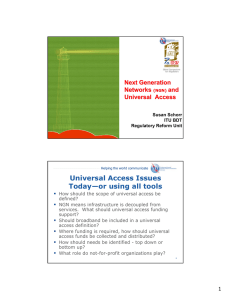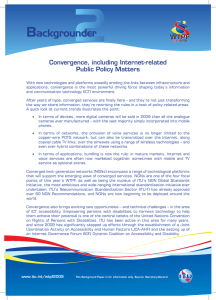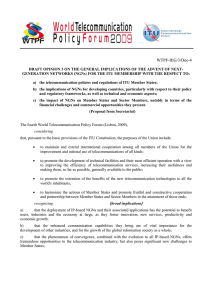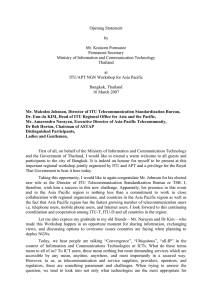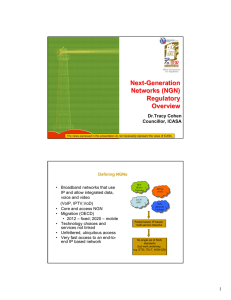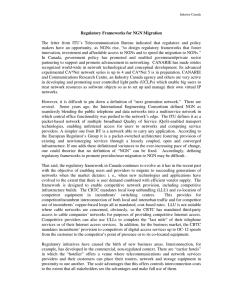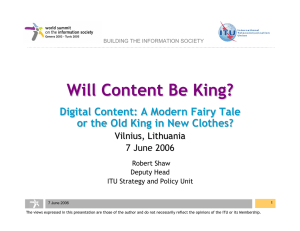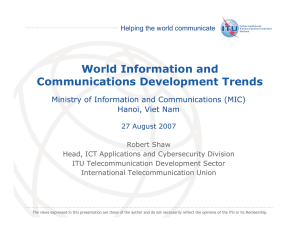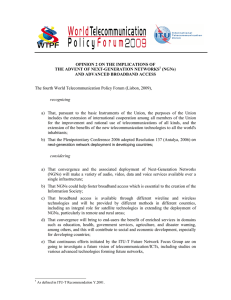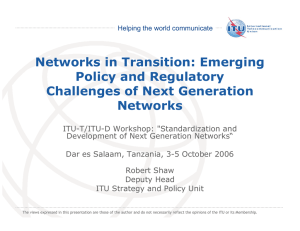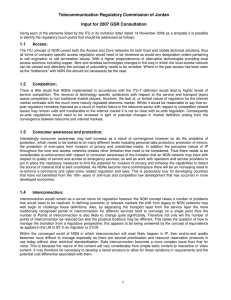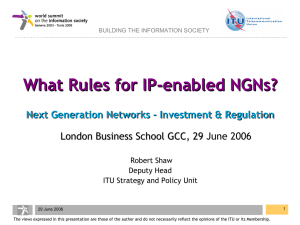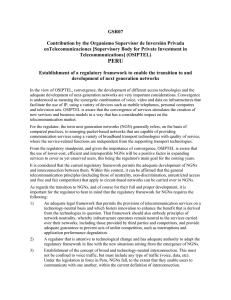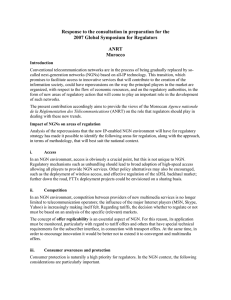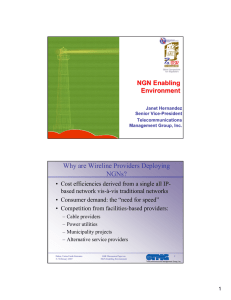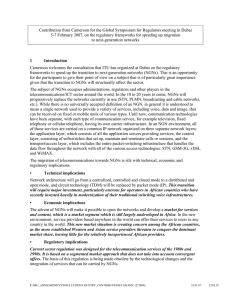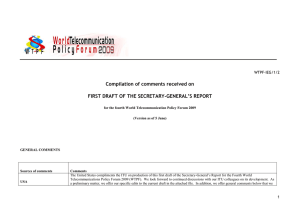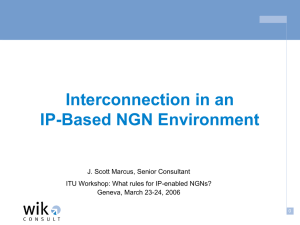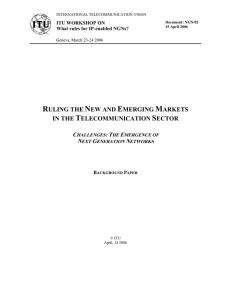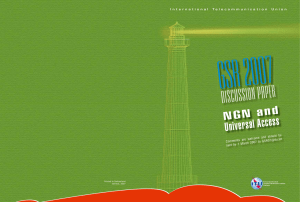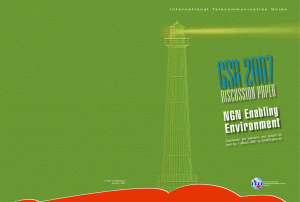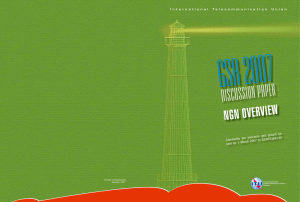B ackgrounder Next-Generation Networks (NGNs)
advertisement
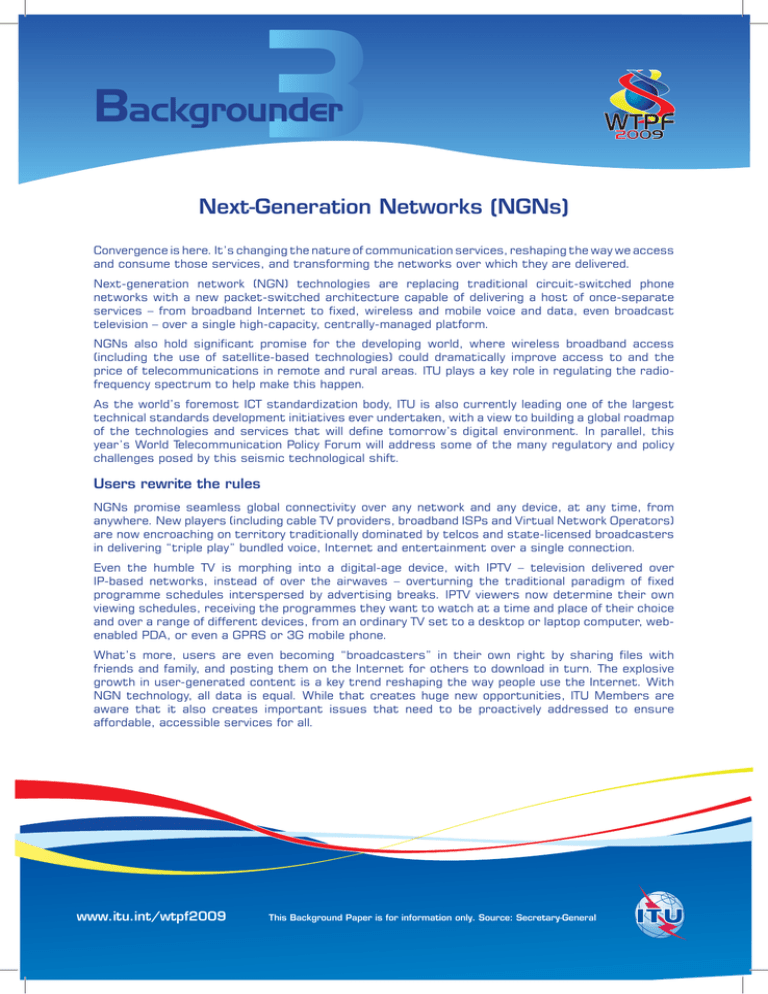
Backgrounder Next-Generation Networks (NGNs) Convergence is here. It’s changing the nature of communication services, reshaping the way we access and consume those services, and transforming the networks over which they are delivered. Next-generation network (NGN) technologies are replacing traditional circuit-switched phone networks with a new packet-switched architecture capable of delivering a host of once-separate services – from broadband Internet to fixed, wireless and mobile voice and data, even broadcast television – over a single high-capacity, centrally-managed platform. NGNs also hold significant promise for the developing world, where wireless broadband access (including the use of satellite-based technologies) could dramatically improve access to and the price of telecommunications in remote and rural areas. ITU plays a key role in regulating the radiofrequency spectrum to help make this happen. As the world’s foremost ICT standardization body, ITU is also currently leading one of the largest technical standards development initiatives ever undertaken, with a view to building a global roadmap of the technologies and services that will define tomorrow’s digital environment. In parallel, this year’s World Telecommunication Policy Forum will address some of the many regulatory and policy challenges posed by this seismic technological shift. Users rewrite the rules NGNs promise seamless global connectivity over any network and any device, at any time, from anywhere. New players (including cable TV providers, broadband ISPs and Virtual Network Operators) are now encroaching on territory traditionally dominated by telcos and state-licensed broadcasters in delivering “triple play” bundled voice, Internet and entertainment over a single connection. Even the humble TV is morphing into a digital-age device, with IPTV – television delivered over IP-based networks, instead of over the airwaves – overturning the traditional paradigm of fixed programme schedules interspersed by advertising breaks. IPTV viewers now determine their own viewing schedules, receiving the programmes they want to watch at a time and place of their choice and over a range of different devices, from an ordinary TV set to a desktop or laptop computer, webenabled PDA, or even a GPRS or 3G mobile phone. What’s more, users are even becoming “broadcasters” in their own right by sharing files with friends and family, and posting them on the Internet for others to download in turn. The explosive growth in user-generated content is a key trend reshaping the way people use the Internet. With NGN technology, all data is equal. While that creates huge new opportunities, ITU Members are aware that it also creates important issues that need to be proactively addressed to ensure affordable, accessible services for all. www.itu.int/wtpf2009 This Background Paper is for information only. Source: Secretary-General Next-Generation regulation? While NGNs are streamlining content and service delivery, they are also posing complex challenges for regulation. Before convergence transformed the ICT landscape, individual services ran on separate networks optimized for the services they carried – so the public switched telephone network (PSTN) delivered high-quality voice services, the Internet excelled in the cheap transportation of packets (at the expense of service quality and security), and broadcasting networks delivered one-way video and audio services in line with national broadcasting regulations. Now, as the provision of more of these services – video, voice, radio, TV – begins to move onto IP-based networks, the digital bits and bytes “co-mingle” and one service becomes indistinguishable from another, as they travel across networks. The prioritization of traffic to ensure quality of services becomes an urgent and complex issue. In an NGN world, should different bit streams be regulated differently – and if so, how? With individuals in the driving seat as both the consumers and generators of content, can governments exercise any degree of control to ensure that offensive or exploitative material is not distributed widely? And in a world where any content can be accessed at any time, from virtually anywhere, how can minors be protected? Issues including copyright and distribution of content, advertising and consumer protection can also prove more controversial in the online world, where content can be disseminated instantaneously, at the click of a mouse. The distribution of audiovisual material can have major commercial consequences – for example, the music industry is seeing its model for content distribution of the last forty years being rewritten by the availability of cheap and sometimes unlawful music content over the Internet. For the moment, the answers to these questions are still far from clear. The clearly defined regulation that has traditionally characterized the telecommunication and broadcasting spheres is coming into conflict with the Internet community’s values of self-regulation, where content and applications are judged on their own merit and utility to users, and control is viewed as anathema. Our NGN future ITU’s 2009 World Telecommunication Policy Forum will bring together an estimated 1000 delegates from across the ICT sector to debate the policy and regulatory issues raised by the deployment of NGNs, which has already begun in earnest in countries including the Republic of Korea, Japan, and parts of the US and western Europe. A unique gathering of national leaders, senior policy-makers and technical experts, the Forum will foster open, in-depth dialogue and promote innovative, shared approaches to realizing the vision of an NGN future. With the current economic crisis now threatening to derail investment in NGN, forging investmentoriented NGN policies will also be a key priority. Delegates will be looking at a range of potential strategies to drive roll-out, from public-private partnerships to the new kinds of infrastructure sharing approaches that were showcased at ITU’s 2008 Global Symposium for Regulators, which can dramatically cut deployment costs while accelerating the roll-out of services to users. International Telecommunication Union Place des Nations CH-1211 Geneva 20 – Switzerland
